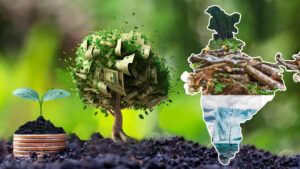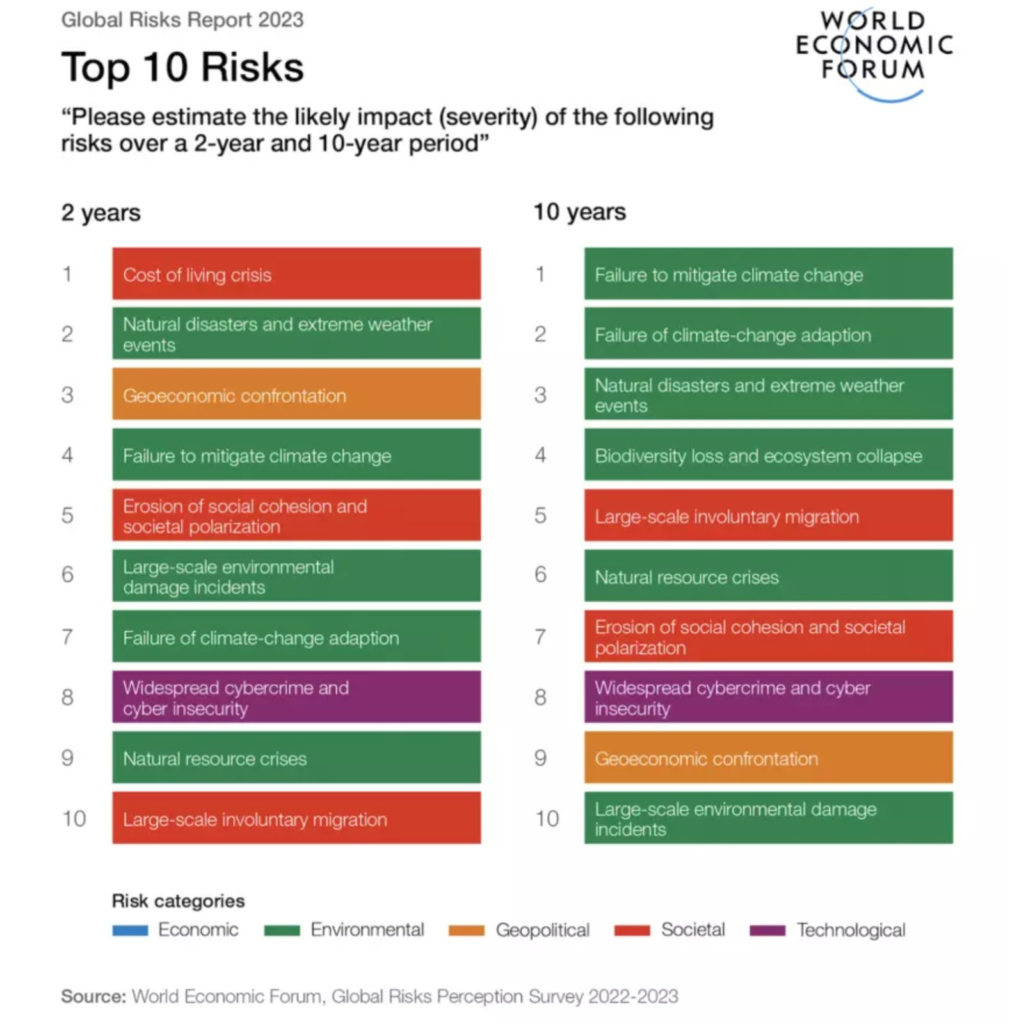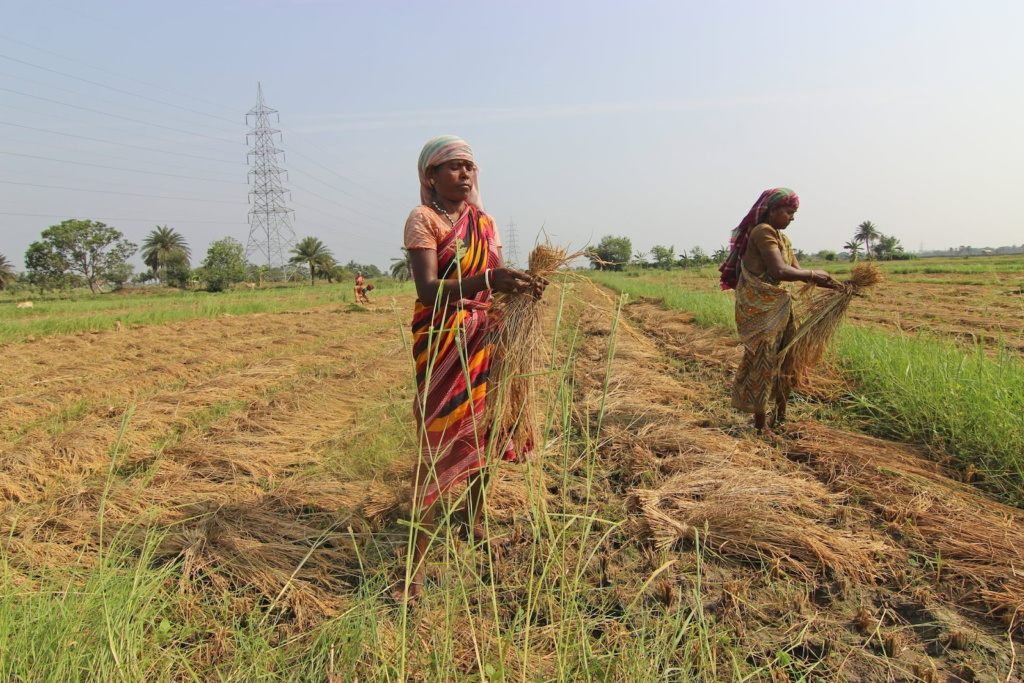Physical Address
23,24,25 & 26, 2nd Floor, Software Technology Park India, Opp: Garware Stadium,MIDC, Chikalthana, Aurangabad, Maharashtra – 431001 India
Physical Address
23,24,25 & 26, 2nd Floor, Software Technology Park India, Opp: Garware Stadium,MIDC, Chikalthana, Aurangabad, Maharashtra – 431001 India

By Aayushi Sharma
India is in an intriguing situation in terms of economic growth hindered by climate change. The devastating consequences of climate change would negatively affect a number of industries, including agriculture, forestry, fisheries, tourism, and ecosystems. It will also have an adverse effect on vital natural resources, infrastructure, human health, and productivity.
As a result, there are numerous indirect effects of climate change that go beyond its direct effects and have the potential to have a significant impact on the development or decline of economies around the world.
According to the Global Risk Report 2023 by the World Economic Forum, the global risk with top severity in the next 10 years is ‘Failure to mitigate climate change’.

Here is how changes in different climatic conditions has impacted Indian economy in numerous ways:
According to a study by IIT Delhi, Global warming has caused the Indian economy to be 31% smaller. Climate change is already taking place in India. It’s anticipated that unusually hot seasons would happen more frequently and span considerably wider areas. The west coast and southern India are predicted to transition to new, high-temperature climatic regimes with severe agricultural consequences under 4°C warming. Agricultural production may be significantly impacted by heat waves. They are capable of ruining crops, lowering output, and killing livestock.

In these severe hotspots in India, the GDP loss could go as high as 9.8% against the national average of 2.8%.
The majority of Himalayan glaciers have been retreating over the past century because the summer monsoon provides a significant portion of their moisture. Between 1901 and 2014, the Hindu Kush Himalayan region’s annual mean temperature climbed continuously by 0.1°C per decade, which further boosted global temperatures at a rate of roughly 0.2°C per decade between 1951 and 2014.
The amount of food that can be produced in the basins of the Indus, Ganges, and Brahmaputra rivers as well as the livelihoods of millions of people would all be significantly impacted by changes in river flows.
Since the 1950s, a decrease in monsoon rainfall has already been noted. Events with a lot of rain have happened more frequently as well. India’s summer monsoon will become extremely unpredictable with a 2°C increase in global average temperatures.
By the end of the century, it is predicted that an exceptionally rainy monsoon, which currently has a probability of happening only once every 100 years, will happen every ten years with a 4°C warming. In broad portions of India, increased flooding as well as more frequent droughts could result from an abrupt change in the monsoon, setting off a serious crisis. Rainfall that is above average may fall in the coastal region of northwest to southeast India.
Wet years are predicted to be wetter, and dry years to be drier. There is evidence that certain regions of South Asia have become drier and more drought-prone since the 1970s. Droughts have serious repercussions. More than half of India’s cropland was damaged by droughts in 1987 and 2002–2003, which significantly reduced crop production. In some regions, particularly in north-western India, Jharkhand, Orissa, and Chhattisgarh, droughts are anticipated to occur more frequently. By the 2040s, excessive heat is predicted to have a significant negative impact on crop output.
India is heavily reliant on groundwater because more than 60% of its agriculture depends on rain. 15% of India’s groundwater supplies are overutilized even in the absence of climate change. The rising demand for water from a growing population, more affluent lifestyles, the services sector, and industry, along with the fact that it is difficult to anticipate future groundwater levels, should cause declining water tables to further decline. Future water demand will be extremely difficult to meet, even in the absence of climate change. The problem is anticipated to get worse due to urbanization, population increase, economic development, and rising water demand from industry and agriculture.
Water shortages are predicted to get worse in some places due to an increase in monsoon rainfall variability. According to studies, the threat to water security is particularly significant over central India, along the Western Ghats mountain range, and in the northeastern regions of India.
With a substantial portion of the city constructed on reclaimed land below the high tide mark, Mumbai has the greatest population exposed to coastal flooding in the whole world. The risks of seawater intrusion are further increased by rapid and uncontrolled urbanization. India’s proximity to the equator means that sea levels would rise far more rapidly on the subcontinent than at higher latitudes. The coastal areas would experience saltwater intrusion as a result of sea-level rise and storm surges, which would affect agriculture, degrade groundwater quality, contaminate drinking water, and perhaps result in an increase in diarrhea cases and cholera epidemics because the cholera bacterium can survive longer in saltwater.
Due to their high population densities, Kolkata and Mumbai are particularly susceptible to the effects of riverine flooding, tropical storms, and sea level rise.
Impact on Agriculture, Infrastructure and food security
Around 700 million people live in rural areas and rely on climatically vulnerable economic sectors including agriculture, forestry, and fishing for their food and means of subsistence. Lack of infrastructure and agrarian nature of the central districts of India make them particularly vulnerable to the effects of climate change.
A primary channel for the fall in incomes comes from climate change’s effects on farmers. For farmers, the monsoon and a favorable climate are essential inputs. Increased temperatures and irregular rains reduce crop yields and, as a result, farmers’ incomes. Extreme temperatures and droughts, which are defined as temperatures or rainfall losses 40% higher than the median, reduce farmer incomes by 4–14% for important crops, according to the 2017–18 Economic Survey. Farmers with lower incomes who live in areas with poorer infrastructure and less irrigation are particularly impacted. India is revealed to be the most vulnerable country in Asia, with yields possibly declining agriculture productivity by 18% by 2070.

Due to rising incomes, expanding populations, and increased demand for biofuels, world food costs are predicted to rise even in the absence of climate change.
Rice: yields have grown generally, but India’s rice output has suffered significantly due to rising temperatures and less rainfall towards the conclusion of the growing season. Average rice yields may have been nearly 6% higher (75 million tonnes in absolute terms) in the absence of climate change.
Wheat: According to recent studies, despite greater fertilizer use, wheat yields peaked in India and Bangladesh in 2001 and have not increased since. According to observations, wheat yields have significantly decreased in northern India due to excessively high temperatures (over 34°C), and this situation will only get worse as temperatures rise.
Impact on Energy security
After China and the United States, India is the third-largest GHG emitter in the world. Despite the nation’s efforts to advance the renewable energy agenda, research suggests that the country’s ability to produce renewable energy may be significantly impacted by altering weather patterns brought on by climate change.
The two main power generation methods in India, hydropower and thermal power generation, both of which depend on sufficient water supplies to operate properly, may be compromised by climate-related effects on water resources.
Dr. Sugandha Srivastav, Post doctoral researcher in Environmental Economics, University of Oxford, told CFC India that, “Climate change increases the number of days with extreme heat and prolongs summer. This has a direct impact in terms of increasing the demand for cooling. Hotter temperatures put various types of energy infrastructure at risk. For example, hotter and drier summers impact hydropower which depends on water levels. Coal and nuclear, which depend on water for cooling, are also negatively impacted by climate change due to lower water availability. High temperatures can also affect power lines. In general, the water, energy and climate change nexus should not be ignored.”
“Diversifying the sources of electricity generation is crucial to make the Indian power grid more resilient to extreme weather. Positive steps include the integration of more wind and solar energy – these are not as water-dependent as coal or nuclear – and offer very affordable electricity”, said Dr. Sugandha.
Migration and conflict
People frequently move from disaster-affected or degraded areas to other national and international locations through South Asia. Major transboundary rivers like the Indus and the Ganges-Brahmaputra-Meghna Basin are already experiencing problems between nations due to the increased demand for water.
Climate refugees may become more prevalent as a result of how climate change affects agriculture and livelihoods.
Dr Partha Das, Climate scientist and in-house expert of CFC India said, “We need a robust database on economic cost of climate change from the village to the country level to be available in the public domain to facilitate good research, and policy making at levels of federal and national governance. The historic decision to create a loss and damage fund for the climate vulnerable countries of the world can benefit India only if there is a reliable estimate of the detrimental impact of climate change, caused mainly by climate induced disasters like flood, drought, landslide, cyclones, crop failure, heat extremes, extreme rainfall etc. Therefore, studying the economic impact of climate change can have multiple usefulness to the development initiatives of the country.”
References: